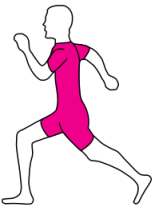How to start
- Start on Twitter, expand to a blog as natural progression.
- Input your blog posts automatically to a Facebook like/fan page.
- Listen to the leading physicians, nurses and patients' voices on Twitter, and reply.
- Comment on blogs.
- Do not be afraid to share your expertise.
- Comply with HIPAA and common sense.
I posted this on Twitter yesterday: Doctors, when you don't have time to write a blog post, record a video - the orthopedic surgeon @hjluks shows how it's done: http://goo.gl/jL73J
Howard J. Luks, MD
@Doctor_V (Bryan Vartabedian) said, "My blog is my home. Twitter and Facebook are outposts."
I actually disagree a bit. My use of Twitter goes beyond a simple outpost. It's my digital notebook and idea feedback system.
The circle of online information for me is as follows: Google Reader -> Share on Twitter -> Get feedback -> Write a blog post -> Share via RSS and Twitter -> Get feedback, go on.
Here is how to facilitate the Rise of the ePhysican who works hand in hand with the ePatient:
This is a list of the Top Twitter Doctors arranged by specialty in alphabetical order - feel free to add your own suggestions. The list is open to anybody to edit:
- Listen to the leading physicians, nurses and patients' voices on Twitter, and reply.
- Comment on blogs.
- Do not be afraid to share your expertise.
- Comply with HIPAA and common sense.
I posted this on Twitter yesterday: Doctors, when you don't have time to write a blog post, record a video - the orthopedic surgeon @hjluks shows how it's done: http://goo.gl/jL73J
Howard J. Luks, MD
@Doctor_V (Bryan Vartabedian) said, "My blog is my home. Twitter and Facebook are outposts."
I actually disagree a bit. My use of Twitter goes beyond a simple outpost. It's my digital notebook and idea feedback system.
The circle of online information for me is as follows: Google Reader -> Share on Twitter -> Get feedback -> Write a blog post -> Share via RSS and Twitter -> Get feedback, go on.
Here is how to facilitate the Rise of the ePhysican who works hand in hand with the ePatient:
Substance over style
Going back to the video embedded above, I think that @hjluks is the current leader in creating original, honest, tell-it-like-it-is clinical content among physicians. This is an example to follow. The technical execution does not have to be perfect, as you will see from the discussion started on Twitter and summarized below. However, the content must be factually correct and professional.
@yayayarndiva (P. Mimi Poinsett MD) had a few comments about the technical aspects of the video such as "if you are going to do a video - make your background a tad less busy:)"
I actually liked the background - it's "authentic" and gives you something to look at during the 8-minute video.
@hjluks actually polled 100 patients on that. They like the laid back office view.
@yayayarndiva P. (Mimi Poinsett MD) thought that "authentically messy AND 8 min video with a head in bouncing chair - think I would rather read the transcript... I think docs like everyone else can sharpen their presentation skills with video... still good to continue. Video? A talking head doesn't confer authenticity- just a new toy:)... Or you could use Dragon software and dictate your post..."
@ePatientDave (Dave deBronkart) convinced @hjluks to do the transcripts, primarily for Google. "Otherwise, thy pearls of light are hidden under a YouTube bushel. I emphasize it's not just *marketing* SEO - it's for being findable for those in need", said @ePatientDave.
I agree. You need the transcript for SEO and quick info. SEO doesn't just apply to marketing - it's a way for people (real humans) to find you online.
Nothing beats video for authenticity though. I understand the concept of creating technically flawless presentations but if you wait to do a perfect video and you are a busy doctor, you may never do it. The same applies to blog posts - if you are going to write a blog post for 2 months, write a journal article instead.
I had some final encouragement for @hjluks: "You don't have to be pro with video. You are pro as orthopod - who uses video."
I think he liked that.
Going back to the video embedded above, I think that @hjluks is the current leader in creating original, honest, tell-it-like-it-is clinical content among physicians. This is an example to follow. The technical execution does not have to be perfect, as you will see from the discussion started on Twitter and summarized below. However, the content must be factually correct and professional.
@yayayarndiva (P. Mimi Poinsett MD) had a few comments about the technical aspects of the video such as "if you are going to do a video - make your background a tad less busy:)"
I actually liked the background - it's "authentic" and gives you something to look at during the 8-minute video.
@hjluks actually polled 100 patients on that. They like the laid back office view.
@yayayarndiva P. (Mimi Poinsett MD) thought that "authentically messy AND 8 min video with a head in bouncing chair - think I would rather read the transcript... I think docs like everyone else can sharpen their presentation skills with video... still good to continue. Video? A talking head doesn't confer authenticity- just a new toy:)... Or you could use Dragon software and dictate your post..."
@ePatientDave (Dave deBronkart) convinced @hjluks to do the transcripts, primarily for Google. "Otherwise, thy pearls of light are hidden under a YouTube bushel. I emphasize it's not just *marketing* SEO - it's for being findable for those in need", said @ePatientDave.
I agree. You need the transcript for SEO and quick info. SEO doesn't just apply to marketing - it's a way for people (real humans) to find you online.
Nothing beats video for authenticity though. I understand the concept of creating technically flawless presentations but if you wait to do a perfect video and you are a busy doctor, you may never do it. The same applies to blog posts - if you are going to write a blog post for 2 months, write a journal article instead.
I had some final encouragement for @hjluks: "You don't have to be pro with video. You are pro as orthopod - who uses video."
I think he liked that.
Do you need a social media policy for your medical practice?
Another good discussion point was brought up by an office manager of a pediatric group in Chicago: Do you need a social media policy for your medical practice? http://goo.gl/7APvI - I think you do.
Another good discussion point was brought up by an office manager of a pediatric group in Chicago: Do you need a social media policy for your medical practice? http://goo.gl/7APvI - I think you do.
John Sharp and I worked on a social media policy for Cleveland Clinic back in 2005 when all that was a big unknown in healthcare. It still is for many organizations - in terms of professional involvement and outreach. A social media policy provides some much needed guidance and boundaries.
The number one rule is very simple: comply with HIPAA and do not share any of the 18 identifiers: http://goo.gl/WR5MR
12-Word Social Media Policy by Mayo Clinic: "Don’t Lie, Don’t Pry, Don’t Cheat, Can’t Delete, Don’t Steal, Don’t Reveal" (http://goo.gl/1Jwdo).
12-Word Social Media Policy by Mayo Clinic: "Don’t Lie, Don’t Pry, Don’t Cheat, Can’t Delete, Don’t Steal, Don’t Reveal" (http://goo.gl/1Jwdo).
Top Twitter Doctors
Comments from Twitter and Facebook:
Bryan Vartabedian: "When I present this stuff I recommend doctors find 2-3 role models in their specialty and follow them. Watch and study how they do things. Great place to start."
Related reading
What are the Downsides of Social Media for Doctors? Dr. Wes shares insights from 6 years of blogging
Related reading
What are the Downsides of Social Media for Doctors? Dr. Wes shares insights from 6 years of blogging







